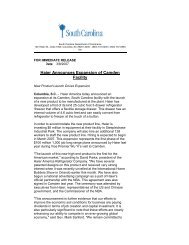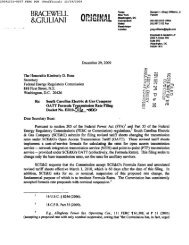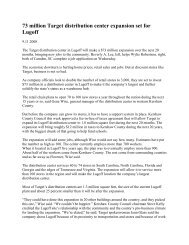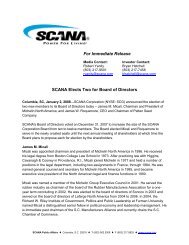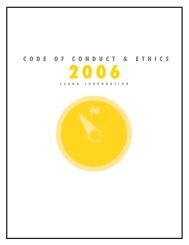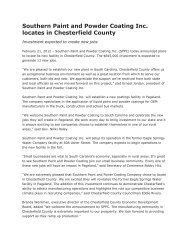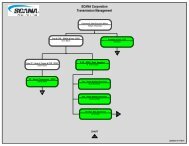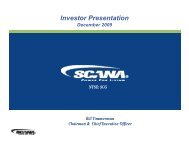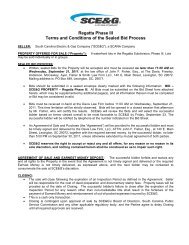10-K - SCANA Corporation
10-K - SCANA Corporation
10-K - SCANA Corporation
You also want an ePaper? Increase the reach of your titles
YUMPU automatically turns print PDFs into web optimized ePapers that Google loves.
Table of Contents<br />
Fuel costs, emission allowances and certain environmental reagent costs for electric generation are collected through the fuel<br />
cost component in retail electric rates. This component is established by the SCPSC during annual fuel cost hearings. Any difference<br />
between actual fuel costs and amounts contained in the fuel cost component is deferred and included when determining the fuel cost<br />
component during the next annual hearing.<br />
SCE&G customers subject to a PGA are billed based on a cost of gas factor calculated in accordance with a gas cost recovery<br />
procedure approved by the SCPSC and subject to adjustment monthly. Any difference between actual gas costs, including the results<br />
of its hedging program, and amounts contained in rates is deferred and included when making the next adjustment to the cost of gas<br />
factor. PSNC Energy’s PGA mechanism authorized by the NCUC allows the recovery of all prudently incurred gas costs, including<br />
the results of its hedging program, from customers. Any difference between actual gas costs and amounts contained in rates is deferred<br />
and included when establishing gas costs during subsequent PGA filings or in annual prudence reviews.<br />
SCE&G’s gas rate schedules for residential, small commercial and small industrial customers include a WNA which<br />
minimizes fluctuations in gas revenues due to abnormal weather conditions. In August 20<strong>10</strong>, SCE&G implemented an eWNA on a<br />
one-year pilot basis for its electric customers, and it will continue on a pilot basis unless modified or terminated by the SCPSC.<br />
PSNC Energy is authorized by the NCUC to utilize a CUT which allows it to adjust base rates semi-annually for residential<br />
and commercial customers based on average, per customer consumption, whether impacted by weather or other factors.<br />
Taxes that are billed to and collected from customers are recorded as liabilities until they are remitted to the respective taxing<br />
authority. Accordingly, no such taxes are included in revenues or expenses in the statements of income.<br />
Earnings Per Share<br />
The Company computes basic earnings per share by dividing net income by the weighted average number of common shares<br />
outstanding for the period. The Company computes diluted earnings per share using this same formula, after giving effect to securities<br />
considered to be dilutive potential common stock. The Company uses the treasury stock method in determining total dilutive potential<br />
common stock. The Company has issued no securities that would have an antidilutive effect on earnings per share.<br />
A reconciliation of the weighted average number of common shares for each of the three years ended December 31, 2011 for<br />
basic and diluted purposes is as follows:<br />
In Millions 2011 20<strong>10</strong> 2009<br />
Weighted Average Shares Outstanding—Basic 128.8 125.7 122.1<br />
Net effect of dilutive stock-based compensation plans and equity<br />
forward contracts 1.4 0.6 0.1<br />
Weighted Average Shares Outstanding—Diluted 130.2 126.3 122.2<br />
New Accounting Matters<br />
Effective for the first quarter of 2012, the Company will adopt accounting guidance that revises how comprehensive income<br />
is presented in its financial statements. The Company does not expect the adoption of this guidance to impact results of operations,<br />
cash flows or financial position.<br />
Effective for the first quarter of 2012, the Company will adopt accounting guidance that permits it to make a qualitative<br />
assessment about the likelihood of goodwill impairment each year. The results of such an assessment may lead the Company to<br />
determine that performing a two-step quantitative impairment test is unnecessary. The Company does not expect the adoption of this<br />
guidance to impact results of operations, cash flows or financial position.<br />
63



